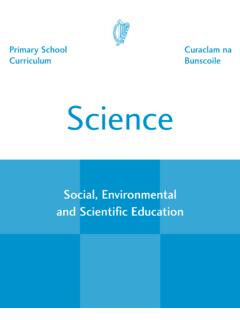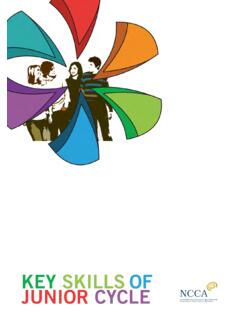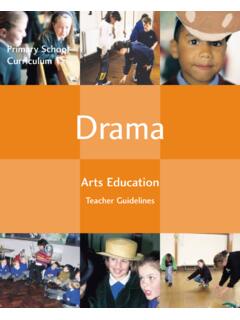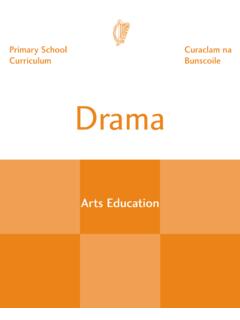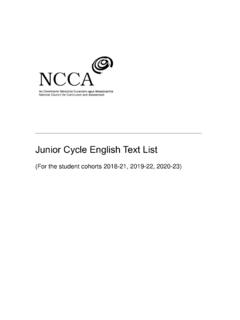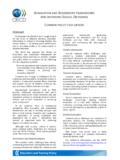Transcription of Primary School Curaclam na Curriculum Bunscoile …
1 PhysicalEducationPrimary SchoolCurriculumCuraclam naBunscoileD U B L I NPUBLISHED BY THE STAT I O N E RY OFFICETo be purc h ased dire c t ly from theG OVERNMENT PUBLICATIONS SALE OFFICESUN ALLIANCE HOUSEM O L E S WO RTH ST R E E TDUBLIN 2or by mail order fro mG OVERNMENT PUBLICAT I O N SP O STAL TRADE SECTION4-5 HARC O U RT ROA DDUBLIN 2( Tel: 01 - 6476834-5; Fax: 01 - 4752760 )or through any booksellerD esign Consulta n cy :B ra d l ey McGurk Pa rt n e rs h i pD esigned by :The Identity Busines sTy p es e tt i n g :Spectrum Print ManagementP r i n ted by :Mozzon Giuntina - Florence andOfficine Grafiche De Agostini - Nova ra 1999 Government of Ire l a n dPhysicalEducationCurriculumC o n te n tsIntroduction Physical education2 The physical education curriculum2 Aims 10 Broad objectives11 Planning content for physical education13 Infant classesOverview15 Content 16 First and second classesOverview25 Content 26 Third and fourth classesOverview37 Content 38 Physical Education CurriculumFifth and sixth classesOverview49 Content 50 Aquatics for infant to sixth classesAquatics for infant to sixth classes62 AssessmentAssessment68 AppendixGlossary78 Membership of the Curriculum Committee for Physical Education82 Membership of the Primary Co-ordinating Committee83
2 IntroductionPhysical education provides children with learning opportunities throughthe medium of movement and contributes to their overall development byhelping them to lead full, active and healthy physical education curriculumPhysical education is distinguished from other curricular areas by itsprimary focus on the body and on physical experience and is an integralpart of the educational process, without which the education of the childis incomplete. Through a diverse range of experiences providing regular,challenging physical activity, the balanced and harmonious deve l o p m e n tand general well-being of the child is education meets the physical needs of the child and the need formovement experiences, challenges and play.
3 It develops a desire for dailyphysical activity and encourages constructive use of free time andparticipation in physical activities in adult life. To fulfil these needs,physical education is built on the principles of variety and diversity, notof specialisation. It provides a wide variety of movement activitiesappropriate to the level of development of the physical education the child can experience the joy of physicalexertion and the satisfaction of achievement while developing skills andpositive attitudes that enhance self-esteem. Physical education providesopportunities to develop desirable personal and social attributes: theconcept of fair play, the acceptance of success and failure, and the abilityto co-operate in group situations.
4 These opportunities contribute to theunderstanding and promotion of a healthy life-style. Physical education,as an integral part of the total Curriculum , provides vital opportunities forthe physical, social, emotional and intellectual development of the content of the physical education curriculumThe Curriculum is divided into six strands: Athletics Dance Gymnastics Games Outdoor and adventure activities education2 AthleticsThe athletics strand provides a variety of opportunities to engage in thenatural activities of running, jumping and throwing. The child needs tolearn to associate joyfulness with these experiences. The emphasis shouldbe on exploring and experimenting with the basic movements of walking,running, jumping and throwing through a wide range of informal playexperiences.
5 Building on these early experiences, children then developthe techniques of running, jumping and throwing as they progressthrough the Primary activities can be devised to encourage children to run and toaccept challenges to their personal performances by running faster or byrunning over a longer distance. Jumping activities will give the child anopportunity to explore various jumps and to develop technique for heightand distance. The child participates in throwing activities using objectsof different shapes and weights and develops a variety of throwingtechniques, improving accuracy and in education involves the child in creating, performing andappreciating movement as a means of expression and differs from the other aspects of the physical educationprogramme in that the Primary concern is with the expressive quality ofmovement and the enjoyment and appreciation of the aesthetic andartistic qualities of dance programme involves the child in a range of creative and folkdance.
6 When creating dance, the child explores a range of body parts,body actions and body shapes. Concepts relating to the body in space,the changing dynamics of movement and the implications of moving inrelation to another person and his/her environment are explored. Thechild is encouraged to dance in response to different stimuli andaccompaniment and to view dance performance. The child s concept ofwhat a dance is can be enriched by opportunities to see and appraise themore accomplished work of dancing is presented with an emphasis on being fully involved andenjoying the dance rather than on the movements involved in the provides the child with a knowledge and experience of dance of Irishand other Education CurriculumGymnasticsGymnastics in education is concerned with the use of movement in acreative way in response to set tasks, both individually and with explore movement on the floor and when negotiating a varietyof equipment.
7 The gymnastics Curriculum encourages children toparticipate in movement experiences that are open to personalinterpretation, providing every child with the opportunity to experiencesuccess at a personal level, by engaging in challenging but realisticallyachievable tasks. As the children progress through a sequential programme they areencouraged to strive for more control over their movements and torespond to more complex tasks. They can be helped to enjoy and developan appreciation of gymnastics while realising individual potential andlimitations, thus enhancing overall games strand fosters the child s natural tendency to play throughinformal play activities. It enhances the development of basic skills, andmany opportunities are provided for social interaction.
8 As skills developin accordance with the stage of development of the child, the desire toapply them in informal activities in competition with others this may occur with a partner and then lead into small-sided ormini-games. As the child progresses to these more formalised games, avariety of games should be provided that develop not only skills but alsounderstanding of such concepts as possession, teamwork, attack, defenceand use of space. If allowed to experiment, the child will invent manygames in which to apply developing skills and understanding. Playground games, co-operative games and games traditional to theschool or locality should be considered when planning a programme forthe School . Gaelic games should be given particular consideration as partof the games programme.
9 Invasion games, net games, striking and fieldinggames, target games and shared court games provide a range ofopportunities for the development of skills and understanding. Small-sided or mini versions of these games encourage maximum balanced programme of such games ensures that the child experiencesa wide variety of activities that provide enjoyment and challenge and thatfoster a lifelong and adventure activitiesOutdoor and adventure activities are facets of the physical educationcurriculum concerned with walking, cycling, camping and water-basedactivities, orienteering, and outdoor challenge , cycling and camping are valuable activities that some schoolsmay organise. Orienteering is an exciting activity that combines thegeographical skills of map work, the physical activity of walking orrunning and the adventure of exploring unfamiliar locations.
10 It can beintroduced through preliminary exercises on the School site. Outdoorchallenge activities include trust or co-operative activities, groupproblem-solving exercises, and physical challenges such as thosepresented by rope courses and adventure play apparatus. Water-basedactivities may be included in the programme, providing opportunities forcanoeing or sailing. These activities, which are mainly non-competitive,offer alternative avenues for pupil achievement and encouragement toadopt a healthy life-style based on an enjoyment and appreciation of aquatics programme is concerned with gaining competence andconfidence near, in, under and on water. It provides unique opportunitiesfor enjoyment, allowing the child the sensation of buoyancy.
